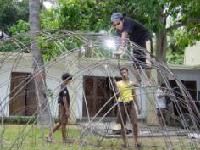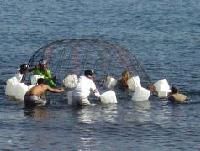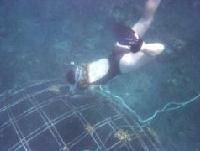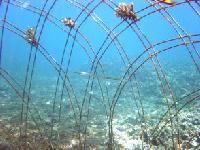 Coral
reefs are among the most biologically diverse ecosystems on
the planet. What you see (picture) left is the profusion of
coral growing off our submerged coral protect structure
after just one year (we have also seen a two-fold increase
in fish)! And this despite the fact sea temperatures have
risen, which means that coral in other areas have suffered
enormously. Coral
reefs are among the most biologically diverse ecosystems on
the planet. What you see (picture) left is the profusion of
coral growing off our submerged coral protect structure
after just one year (we have also seen a two-fold increase
in fish)! And this despite the fact sea temperatures have
risen, which means that coral in other areas have suffered
enormously.Outstanding
examples of our biological and natural heritage, coral reefs
are an important asset to local communities serving as a
source of seafood, providing materials for new medicines,
generating income from tourism, and buffering coastal cities
and settlements from storm damage.
 Yet,
in just a few decades, human activities have devastated many
of these biologically rich, ancient ecosystems. Many people
joke about the people of Nusa Dua, Sanur and Tanjung Benoa
in Bali saying "Has anyone seen our beach?!". Where vast
swathes of beach have washed away due to the destruction of
the coral reef system in those areas. In the next few
decades, more are destined for destruction around the world.
However, some people today are beginning to realize that the
self-healing powers of reef ecosystems are beginning to wear
out and it's high time for active support. Yet,
in just a few decades, human activities have devastated many
of these biologically rich, ancient ecosystems. Many people
joke about the people of Nusa Dua, Sanur and Tanjung Benoa
in Bali saying "Has anyone seen our beach?!". Where vast
swathes of beach have washed away due to the destruction of
the coral reef system in those areas. In the next few
decades, more are destined for destruction around the world.
However, some people today are beginning to realize that the
self-healing powers of reef ecosystems are beginning to wear
out and it's high time for active support.
The, Biorockô method gives rise to
great hopes it's not yet too late for that. And on the 21st
December 2002, a team from the Indonesian Ministry of
Fisheries sponsored coral and fisheries project started work
in conjunction with Villas Agung Bali Nirwana in the waters
directly offshore of the resort.
 The project involved the building and submerging of a large
(around 15 foot in diameter) steel, cage-like structure
which resembles a pizza oven! Through this structure, a low
(6 amp) electric current is passed, which causes a fast
calcium build up on the metal surfaces and creates the ideal
pH for coral growth. These conditions also help compensate
for sometimes fatal changes in sea temperature. Also, the
electric current / calcium build up prevents the structure
from rusting. Although Agung Bali Nirwana is blessed with a
superb, living coral reef anyway. Corals are still under
threat from rising sea temperatures, storm damage and bad
fishing practices.
The project involved the building and submerging of a large
(around 15 foot in diameter) steel, cage-like structure
which resembles a pizza oven! Through this structure, a low
(6 amp) electric current is passed, which causes a fast
calcium build up on the metal surfaces and creates the ideal
pH for coral growth. These conditions also help compensate
for sometimes fatal changes in sea temperature. Also, the
electric current / calcium build up prevents the structure
from rusting. Although Agung Bali Nirwana is blessed with a
superb, living coral reef anyway. Corals are still under
threat from rising sea temperatures, storm damage and bad
fishing practices.
 Corals
transplanted onto the structures attract high densities of
all type of fish. All corals used in the project are broken
pieces found nearby where they would be damaged by rolling
or sedimentation. They would sooner or later die if not
rescued and attached to the nursery structures. Broken
corals are collected from the sea floor and attached with
wires to the structure. Very quickly, calcium carbonate
naturally reinforces the corals attachment to these
structures. Corals
transplanted onto the structures attract high densities of
all type of fish. All corals used in the project are broken
pieces found nearby where they would be damaged by rolling
or sedimentation. They would sooner or later die if not
rescued and attached to the nursery structures. Broken
corals are collected from the sea floor and attached with
wires to the structure. Very quickly, calcium carbonate
naturally reinforces the corals attachment to these
structures.
 Without
needing so much of their own energy to create a calcareous
skeleton, each coral polyp can put more energy into growth
and reproduction. These corals show exceptionally high
growth rates and also thrive even when water quality
conditions have deteriorated to the point of killing
surrounding corals. Without
needing so much of their own energy to create a calcareous
skeleton, each coral polyp can put more energy into growth
and reproduction. These corals show exceptionally high
growth rates and also thrive even when water quality
conditions have deteriorated to the point of killing
surrounding corals.
Not only corals profit from the
Biorockô technology. Great varieties of fishes, also
commercially relevant species like snappers, are attracted
to these sheltered habitats. The increased fish population
can restock the surrounding waters and help to improve the
conditions for the local fishermen.
The Biorockô structure you see above
is what it looked like after the team had just finished the
initial installation stage. Based on experience with other
Biorockô structures elsewhere in the world, very soon the
structure and the area surrounding it will be teaming with
coral growth and fish. Further enhancing the already superb
reef / fish life in front of our villas.
We are doing to this as our
responsibility to future generations, and because it makes
us feel good. But of course, our guests have the added
benefit of being able to look forward to some of the very
best offshore snorkeling and diving in Bali.
http://www.agung-bali-nirwana.com/coral-project/index.html |
